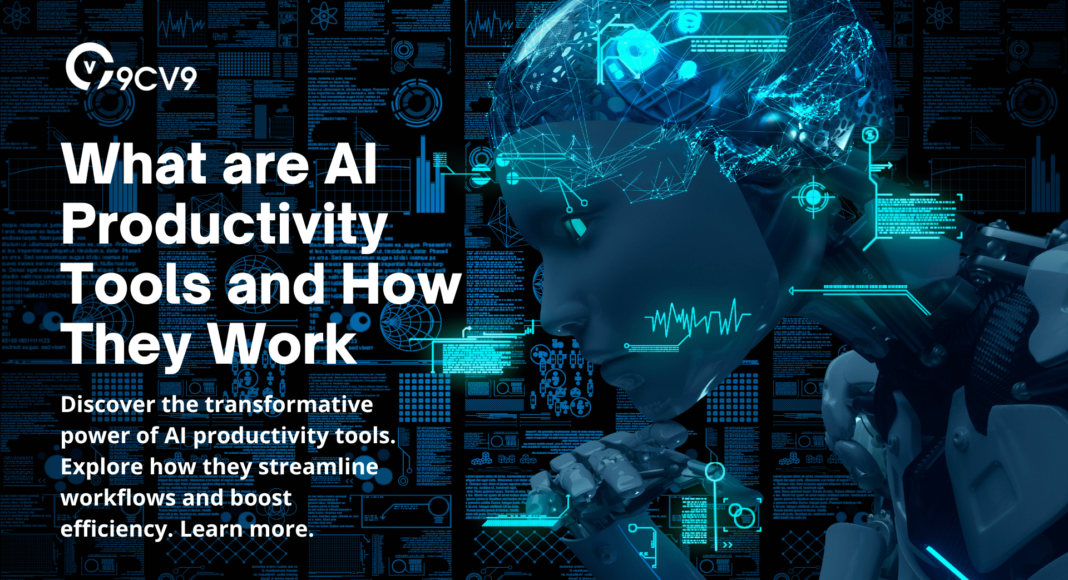Key Takeaways
- Supercharge Efficiency: Explore how AI productivity tools streamline tasks and optimize processes, saving time and boosting productivity.
- Foster Collaboration: Discover how AI-driven communication platforms enhance teamwork and streamline collaboration across teams and departments.
- Future-proof Your Workflow: Embrace the power of AI technology to stay ahead of the curve and unlock new opportunities for innovation and growth in the digital age.
In today’s fast-paced digital landscape, where time is of the essence and efficiency is paramount, businesses and individuals alike are constantly seeking innovative solutions to enhance productivity.
Enter AI productivity tools – the game-changers that are revolutionizing the way we work, collaborate, and achieve our goals.
But what exactly are AI productivity tools, and how do they work their magic?
In this in-depth guide, we’ll embark on a journey to demystify these transformative technologies, uncovering their inner workings, exploring their myriad benefits, and delving into real-world applications that showcase their unparalleled potential.
Imagine a world where mundane tasks are automated, decision-making is augmented with intelligent insights, and collaboration is seamless across teams and departments.
That’s the promise of AI productivity tools – sophisticated software solutions powered by artificial intelligence and machine learning algorithms, designed to supercharge productivity and unleash human potential.
At its core, AI productivity tools encompass a diverse array of applications spanning task management, time tracking, workflow automation, communication enhancement, and data analysis.
From simple to-do lists to complex project management systems, these tools leverage the power of AI to streamline processes, optimize resource allocation, and empower users to accomplish more in less time.
But how do these tools actually work their magic?
The answer lies in their ability to harness the vast amounts of data generated in today’s digital ecosystem, extracting valuable insights, and leveraging predictive analytics to anticipate user needs and optimize performance.
Through advanced algorithms, natural language processing, and machine learning techniques, AI productivity tools adapt to user behavior, learn from past interactions, and continuously refine their recommendations to deliver personalized experiences tailored to individual preferences.
In this guide, we’ll delve deep into the inner workings of AI productivity tools, exploring the intricate mechanisms that drive their functionality and examining the key components that enable them to deliver tangible results.
From data collection and analysis to automation and optimization, we’ll uncover the secrets behind these technological marvels, shedding light on the algorithms, processes, and techniques that power their transformative capabilities.
But the true measure of any technology lies not just in its theoretical potential but in its real-world applications and tangible impact.
That’s why we’ll also explore a series of compelling case studies that illustrate how AI productivity tools are being deployed across various industries and domains to drive efficiency, enhance collaboration, and fuel innovation.
From startups to Fortune 500 companies, organizations of all sizes and sectors are harnessing the power of AI productivity tools to gain a competitive edge in today’s hyper-competitive marketplace.
Whether it’s automating repetitive tasks, optimizing resource allocation, or uncovering actionable insights from vast datasets, these tools are enabling businesses to work smarter, not harder, and achieve their goals with unprecedented speed and precision.
But as with any transformative technology, realizing the full potential of AI productivity tools requires more than just adopting the latest tools and technologies.
It requires a strategic approach, thoughtful implementation, and a commitment to ongoing learning and optimization.
That’s why we’ll also provide a comprehensive guide to best practices for leveraging AI productivity tools effectively, offering practical tips and strategies for selecting the right tools, integrating them into existing workflows, and maximizing their impact on productivity and performance.
Moreover, as we look to the future, we’ll explore the emerging trends and innovations that are shaping the evolution of AI productivity tools, from advancements in natural language processing and predictive analytics to the integration of emerging technologies like blockchain and IoT.
We’ll also examine the ethical considerations and data privacy concerns that accompany the widespread adoption of AI technologies, offering insights into how businesses can navigate these challenges while harnessing the full potential of AI to drive growth and innovation.
In conclusion, AI productivity tools represent a paradigm shift in how we work, collaborate, and achieve our goals in the digital age.
By harnessing the power of artificial intelligence, these transformative technologies have the potential to revolutionize the way we approach productivity, unlocking new opportunities for innovation, efficiency, and success.
So join us on this journey as we unravel the mysteries of AI productivity tools and discover how they can propel your business to new heights of success.
Before we venture further into this article, we like to share who we are and what we do.
About 9cv9
9cv9 is a business tech startup based in Singapore and Asia, with a strong presence all over the world.
With over eight years of startup and business experience, and being highly involved in connecting with thousands of companies and startups, the 9cv9 team has listed some important learning points in this overview of What are AI Productivity Tools and How They Work.
If your company needs recruitment and headhunting services to hire top-quality employees, you can use 9cv9 headhunting and recruitment services to hire top talents and candidates. Find out more here, or send over an email to [email protected].
Or just post 1 free job posting here at 9cv9 Hiring Portal in under 10 minutes.
What are AI Productivity Tools and How They Work
- Understanding AI Productivity Tools
- How AI Productivity Tools Work
- Best Practices for Leveraging AI Productivity Tools
- Future Trends and Innovations
1. Understanding AI Productivity Tools
In this section, we’ll dive deep into the world of AI productivity tools, exploring their definition, scope, types, and the myriad benefits they offer to businesses and individuals alike.
Through real-world examples and case studies, we’ll illustrate how AI productivity tools are transforming workflows, streamlining processes, and driving efficiency across various industries.

Definition and Scope
- Definition: AI productivity tools refer to software applications powered by artificial intelligence and machine learning algorithms, designed to enhance productivity, streamline workflows, and optimize resource allocation.
- Scope: These tools encompass a wide range of applications, including task management, time tracking, workflow automation, communication enhancement, and data analysis.
Types of AI Productivity Tools
- Task Management Tools:
- Examples: Asana, Trello, Monday.com
- These tools utilize AI algorithms to prioritize tasks, assign deadlines, and optimize task allocation based on user behavior and project requirements.
- Time Tracking Solutions:
- Examples: Toggl, Harvest, Clockify
- AI-powered time tracking tools automate the process of tracking billable hours, analyzing time usage patterns, and generating insightful reports to improve time management and efficiency.
- Workflow Automation Platforms:
- Examples: Zapier, Microsoft Power Automate, Integromat
- These platforms leverage AI to automate repetitive tasks, streamline business processes, and integrate disparate systems, allowing users to focus on high-value activities.
- Communication Enhancement Platforms:
- Examples: Slack, Microsoft Teams, Zoom
- AI-driven communication tools facilitate seamless collaboration, intelligent message prioritization, and personalized recommendations to enhance team productivity and effectiveness.
- Data Analysis and Insights Tools:
- Examples: Tableau, Google Analytics, IBM Watson Analytics
- AI-powered data analysis tools enable businesses to extract actionable insights from large datasets, uncover trends, and make data-driven decisions to drive growth and innovation.

Benefits of AI Productivity Tools
- Efficiency Improvement:
- AI algorithms optimize workflows, automate repetitive tasks, and streamline processes, resulting in significant time and cost savings for businesses.
- Example: By automating routine administrative tasks such as scheduling meetings and organizing emails, virtual assistants like Google Assistant and Siri enhance productivity and efficiency.
- Time-saving Capabilities:
- AI-powered time tracking tools automate the process of tracking billable hours, eliminating the need for manual time entry and reducing administrative overhead.
- Example: Toggl’s AI-powered time tracking features analyze user behavior patterns and provide personalized time management recommendations to improve productivity.
- Enhanced Decision-making:
- AI algorithms analyze vast amounts of data, extract actionable insights, and provide predictive analytics to support informed decision-making.
- Example: Tableau’s AI-driven analytics platform uses machine learning algorithms to identify trends, patterns, and outliers in data, empowering businesses to make data-driven decisions with confidence.
- Personalized Recommendations:
- AI-powered productivity tools leverage user data and behavior patterns to deliver personalized recommendations, task prioritization, and workflow optimization suggestions.
- Example: Asana’s AI-powered task management features analyze user preferences and project requirements to suggest task prioritization, deadlines, and resource allocation strategies tailored to individual needs.
- Streamlined Collaboration:
- AI-driven communication platforms facilitate seamless collaboration, intelligent message prioritization, and personalized recommendations to enhance team productivity and effectiveness.
- Example: Slack’s AI-powered chatbots automate routine tasks, provide relevant information, and facilitate real-time collaboration among team members, improving communication and workflow efficiency.
Through these examples and insights, it becomes clear that AI productivity tools are not just a technological novelty but a transformative force that is reshaping the way we work, collaborate, and achieve our goals in the digital age.
2. How AI Productivity Tools Work
In this section, we’ll explore the inner workings of AI productivity tools, shedding light on the sophisticated algorithms, processes, and techniques that power their transformative capabilities.
Data Collection and Analysis
- Integration of Multiple Data Sources:
- AI productivity tools collect data from various sources, including user inputs, application logs, and external data feeds, to gain a comprehensive understanding of user behavior and preferences.
- Example: Customer relationship management (CRM) systems like Salesforce integrate data from sales, marketing, and customer service interactions to provide a holistic view of customer relationships and drive personalized engagement strategies.
- Machine Learning Algorithms:
- AI-powered tools utilize machine learning algorithms to analyze large datasets, identify patterns, and extract valuable insights that inform decision-making and drive productivity improvements.
- Example: Google Workspace’s Smart Compose feature uses natural language processing (NLP) algorithms to analyze user writing patterns and suggest contextually relevant email responses, saving time and improving communication efficiency.

Automation and Optimization
- Predictive Analytics:
- AI productivity tools leverage predictive analytics to anticipate user needs, automate routine tasks, and proactively recommend actions that optimize workflow efficiency.
- Example: Adobe Sensei, Adobe’s AI and machine learning platform, analyzes user interactions with creative assets to predict design preferences, automate repetitive tasks, and streamline the creative process.
- Natural Language Processing (NLP):
- NLP algorithms enable AI productivity tools to understand and interpret human language, facilitating intelligent automation, sentiment analysis, and personalized communication.
- Example: Chatbots like Zendesk’s Answer Bot utilize NLP to analyze customer inquiries, identify relevant information, and provide accurate responses in real-time, reducing response times and improving customer satisfaction.
User Interaction and Customization
- User-friendly Interfaces:
- AI productivity tools feature intuitive interfaces that simplify user interactions, enhance usability, and facilitate seamless integration into existing workflows.
- Example: Microsoft Teams’ AI-driven interface dynamically adjusts layout and content based on user preferences and context, providing a personalized and intuitive collaboration experience.
- Customization Options:
- AI-powered tools offer customization options that enable users to tailor their experiences, preferences, and workflows to suit their unique needs and preferences.
- Example: Todoist, a task management application, allows users to create custom filters, labels, and priorities, empowering them to organize tasks and manage projects in a way that aligns with their individual preferences and workflows.
Continuous Learning and Improvement
- Feedback Mechanisms:
- AI productivity tools incorporate feedback mechanisms that enable users to provide input, corrections, and preferences, facilitating continuous learning and improvement.
- Example: Grammarly, a writing assistant tool, uses user feedback to refine its grammar and style suggestions, improving accuracy and relevance over time based on user preferences and corrections.
- Adaptive Algorithms:
- AI-powered tools employ adaptive algorithms that learn from user interactions, adjust recommendations, and adapt to changing user needs and preferences over time.
- Example: Amazon’s recommendation engine analyzes user browsing and purchasing history to deliver personalized product recommendations, continuously refining its algorithms to improve relevance and accuracy.
By harnessing the power of data analysis, automation, and machine learning, AI productivity tools empower users to work smarter, not harder, by automating routine tasks, optimizing workflows, and providing personalized recommendations that enhance efficiency and productivity.
Through continuous learning and improvement, these tools evolve to meet the ever-changing needs of users and organizations, driving innovation and driving success in the digital age.
3. Best Practices for Leveraging AI Productivity Tools
In this section, we’ll outline key best practices for effectively leveraging AI productivity tools to maximize their impact on efficiency, collaboration, and performance.
Through practical tips and strategies, backed by real-world examples, we’ll help businesses and individuals harness the full potential of AI technology to drive productivity and success.
Choosing the Right Tools for Your Needs
- Evaluate Your Requirements:
- Assess your specific business needs, workflows, and pain points to identify areas where AI productivity tools can make the most significant impact.
- Example: A marketing team may benefit from AI-powered analytics tools to optimize ad campaigns and target audience segmentation based on data insights.
- Research and Compare Options:
- Conduct thorough research and compare features, functionality, and pricing of different AI productivity tools to find the best fit for your organization.
- Example: Compare project management platforms like Asana, Trello, and Monday.com to determine which one offers the most suitable features and integrations for your team’s needs.

Integrating AI Tools into Existing Workflows
- Assess Compatibility and Integration:
- Ensure that the selected AI productivity tools seamlessly integrate with your existing software stack and workflows to minimize disruption and maximize efficiency.
- Example: Choose CRM solutions like HubSpot or Salesforce that offer robust integrations with AI-powered marketing automation tools like Marketo or Mailchimp.
- Provide Adequate Training and Support:
- Offer comprehensive training and support resources to help users familiarize themselves with the features and functionality of AI productivity tools and maximize their utility.
- Example: Provide onboarding sessions, tutorials, and knowledge base articles to educate employees on how to effectively use AI-driven collaboration platforms like Microsoft Teams or Slack.
Monitoring and Measuring Performance Metrics
- Define Key Performance Indicators (KPIs):
- Establish clear KPIs and benchmarks to measure the impact of AI productivity tools on productivity, efficiency, collaboration, and overall business performance.
- Example: Track metrics such as task completion rates, time saved, and project turnaround times to assess the effectiveness of AI-powered project management tools like Basecamp or Jira.
- Regularly Monitor and Analyze Metrics:
- Continuously monitor and analyze performance metrics to identify areas for improvement, optimize workflows, and make data-driven decisions to drive productivity gains.
- Example: Use analytics dashboards provided by AI productivity tools to track user engagement, adoption rates, and usage patterns, and identify opportunities for optimization.
Continuous Evaluation and Optimization
- Gather User Feedback:
- Solicit feedback from users to understand their pain points, preferences, and suggestions for improvement, and use this input to iterate and optimize AI productivity tools.
- Example: Conduct regular surveys, focus groups, or feedback sessions to gather insights from employees on their experience using AI-driven collaboration tools like Zoom or Microsoft Teams.
- Stay Updated on Emerging Trends:
- Stay abreast of the latest advancements and emerging trends in AI technology and productivity tools to ensure that your organization remains competitive and leverages cutting-edge solutions.
- Example: Explore emerging AI-powered productivity tools like virtual meeting assistants or AI-driven document collaboration platforms to stay ahead of the curve and unlock new opportunities for efficiency and innovation.
By following these best practices, businesses can effectively leverage AI productivity tools to streamline workflows, enhance collaboration, and drive tangible improvements in productivity and performance.
Through careful selection, seamless integration, ongoing monitoring, and continuous optimization, organizations can harness the full potential of AI technology to achieve their goals and succeed in the digital age.
4. Future Trends and Innovations
In this section, we’ll explore the emerging trends and innovations that are shaping the future of AI productivity tools.
From advancements in AI technology to the integration of emerging technologies, we’ll examine how these developments are poised to revolutionize the way we work, collaborate, and achieve our goals.
Evolution of AI in Productivity Tools
- Advancements in Natural Language Processing (NLP):
- Enhanced NLP algorithms will enable AI productivity tools to better understand and interpret human language, facilitating more natural interactions and intelligent automation.
- Example: Future iterations of virtual assistants like Siri or Google Assistant may be capable of understanding and responding to complex commands and queries with greater accuracy and contextual understanding.
- Integration of Machine Learning and Predictive Analytics:
- AI productivity tools will leverage machine learning algorithms and predictive analytics to anticipate user needs, automate tasks, and provide proactive recommendations that optimize workflow efficiency.
- Example: Project management platforms may utilize predictive analytics to forecast project timelines, identify potential bottlenecks, and recommend resource allocation strategies to ensure on-time delivery.
Impact of Emerging Technologies
- Blockchain Integration:
- Integration of blockchain technology into AI productivity tools will enhance data security, transparency, and trust, enabling secure and verifiable transactions and collaborations.
- Example: Blockchain-based document management systems could provide immutable records of document revisions, ensuring data integrity and traceability in collaborative workflows.
- Internet of Things (IoT) Integration:
- Integration of IoT devices with AI productivity tools will enable seamless data exchange and automation, enhancing efficiency and enabling new use cases in smart workplaces.
- Example: AI-powered task management tools could integrate with IoT sensors to automatically generate tasks based on environmental conditions or equipment status, improving workflow efficiency and asset management.
Personalization and Customization Trends
- Hyper-personalization:
- AI productivity tools will offer increasingly personalized and tailored experiences, leveraging user data and behavior patterns to deliver customized recommendations, workflows, and interfaces.
- Example: Virtual meeting platforms may use AI algorithms to personalize meeting agendas, content recommendations, and participant suggestions based on individual preferences and objectives.
- Customization Options:
- AI productivity tools will provide more extensive customization options, allowing users to tailor their experiences, preferences, and workflows to suit their unique needs and preferences.
- Example: Task management applications may offer advanced customization features such as custom workflows, task templates, and automation rules, empowering users to optimize their workflows and processes.
Ethical Considerations and Data Privacy Concerns
- Ethical AI Practices:
- With the increasing adoption of AI productivity tools, there will be a growing emphasis on ethical AI practices, transparency, and accountability to ensure fairness, equity, and responsible use of AI technologies.
- Example: AI productivity tool developers may implement ethical AI frameworks and guidelines to mitigate biases, protect privacy, and ensure algorithmic transparency and accountability.
- Data Privacy and Security:
- As AI productivity tools collect and analyze large volumes of sensitive data, there will be heightened concerns and regulations around data privacy, security, and compliance.
- Example: AI productivity tool providers will implement robust data encryption, access controls, and data anonymization techniques to protect user privacy and comply with data protection regulations such as GDPR and CCPA.
By staying informed about these future trends and innovations, businesses can prepare themselves to leverage the latest advancements in AI technology to drive productivity, collaboration, and innovation.
By embracing emerging technologies, prioritizing ethical considerations, and ensuring data privacy and security, organizations can unlock new opportunities for growth and success in the digital age.
Conclusion
In the ever-evolving landscape of modern work, where efficiency, collaboration, and innovation are paramount, AI productivity tools emerge as the cornerstone of success.
Throughout this comprehensive guide, we’ve delved deep into the realm of AI productivity tools, unraveling their intricacies, exploring their capabilities, and envisioning their potential to transform the way we work and achieve our goals.
From the definition and scope of AI productivity tools to their inner workings and real-world applications, we’ve uncovered the transformative power of artificial intelligence and machine learning in streamlining workflows, optimizing processes, and driving efficiency across various industries and domains.
By harnessing the vast amounts of data generated in today’s digital ecosystem, AI productivity tools empower users to work smarter, not harder, by automating routine tasks, providing intelligent insights, and facilitating seamless collaboration.
As we’ve seen, AI productivity tools come in many forms, from task management platforms to time tracking solutions, workflow automation tools, communication enhancement platforms, and data analysis and insights tools.
Each type offers unique features and functionalities designed to address specific business needs and challenges, enabling organizations to unlock new levels of productivity, agility, and innovation.
But the journey doesn’t end with adoption.
To truly harness the power of AI productivity tools, organizations must embrace best practices for implementation, integration, and optimization.
By choosing the right tools for their needs, integrating them seamlessly into existing workflows, and providing adequate training and support, businesses can ensure a smooth transition and maximize the ROI of their AI investments.
Moreover, as we look to the future, we see a landscape ripe with opportunities for innovation and growth.
Advancements in natural language processing, machine learning, and predictive analytics promise to further enhance the capabilities of AI productivity tools, enabling hyper-personalization, customization, and intelligent automation at scale.
Integration with emerging technologies like blockchain and IoT opens new avenues for secure, transparent, and automated workflows, while ethical considerations and data privacy concerns underscore the importance of responsible AI practices and regulatory compliance.
In conclusion, AI productivity tools represent more than just a technological novelty – they are the catalysts for a smarter, more efficient future of work.
By embracing AI technology, organizations can unlock new opportunities for collaboration, creativity, and success, driving productivity gains, cost savings, and competitive advantage in today’s fast-paced digital economy.
So let us harness the power of AI productivity tools to reimagine the way we work, collaborate, and achieve our goals, paving the way for a brighter and more productive tomorrow.
If your company needs HR, hiring, or corporate services, you can use 9cv9 hiring and recruitment services. Book a consultation slot here, or send over an email to [email protected].
If you find this article useful, why not share it with your hiring manager and C-level suite friends and also leave a nice comment below?
We, at the 9cv9 Research Team, strive to bring the latest and most meaningful data, guides, and statistics to your doorstep.
To get access to top-quality guides, click over to 9cv9 Blog.
People Also Ask
What are AI productivity tools?
AI productivity tools are software applications powered by artificial intelligence and machine learning algorithms, designed to enhance productivity, streamline workflows, and optimize resource allocation.
How do AI productivity tools work?
AI productivity tools leverage AI algorithms to automate tasks, analyze data, and provide insights that optimize workflow efficiency and drive productivity gains.
What types of AI productivity tools are available?
AI productivity tools encompass task management, time tracking, workflow automation, communication enhancement, and data analysis tools, each designed to address specific business needs and challenges.
Can AI productivity tools improve efficiency?
Yes, AI productivity tools streamline tasks, automate repetitive processes, and provide intelligent recommendations, resulting in significant efficiency improvements for businesses and individuals alike.
What are the benefits of using AI productivity tools?
AI productivity tools offer benefits such as efficiency improvement, time-saving capabilities, enhanced decision-making, personalized recommendations, and streamlined collaboration across teams and departments.
How can AI productivity tools enhance collaboration?
AI productivity tools facilitate seamless communication, intelligent message prioritization, and personalized recommendations, fostering collaboration and teamwork among users.
Are AI productivity tools suitable for businesses of all sizes?
Yes, AI productivity tools are scalable and adaptable, making them suitable for businesses of all sizes, from startups to large enterprises, seeking to enhance productivity and drive growth.
What role does data analysis play in AI productivity tools?
Data analysis is central to AI productivity tools, as they leverage large datasets to extract valuable insights, identify patterns, and make data-driven decisions that optimize workflow efficiency.
How do AI productivity tools utilize machine learning?
AI productivity tools use machine learning algorithms to analyze data, learn from user behavior, and adapt recommendations and workflows to individual preferences and requirements.
Can AI productivity tools be customized to fit specific needs?
Yes, AI productivity tools offer customization options that allow users to tailor their experiences, preferences, and workflows to suit their unique needs and requirements.
Are AI productivity tools user-friendly?
Yes, AI productivity tools feature intuitive interfaces and user-friendly designs that simplify user interactions, enhance usability, and facilitate seamless integration into existing workflows.
How do AI productivity tools optimize resource allocation?
AI productivity tools analyze data to predict resource needs, automate task assignments, and optimize resource allocation strategies, ensuring efficient use of time and resources.
Are AI productivity tools compatible with other software applications?
Yes, AI productivity tools offer integrations with a wide range of software applications and platforms, enabling seamless data exchange and collaboration across different tools and systems.
What are some examples of AI productivity tools?
Examples of AI productivity tools include task management platforms like Asana and Trello, time tracking solutions like Toggl and Harvest, workflow automation tools like Zapier and Microsoft Power Automate, communication platforms like Slack and Microsoft Teams, and data analysis tools like Tableau and Google Analytics.
How can AI productivity tools improve decision-making?
AI productivity tools provide predictive analytics and data-driven insights that support informed decision-making, helping businesses identify opportunities, mitigate risks, and achieve their goals with confidence.
Can AI productivity tools automate repetitive tasks?
Yes, AI productivity tools automate routine tasks such as data entry, email management, and scheduling, freeing up time for users to focus on high-value activities that drive business growth.
Are AI productivity tools cost-effective?
Yes, AI productivity tools offer a high return on investment by increasing efficiency, reducing labor costs, and driving productivity gains that far outweigh the initial investment in the software.
How do AI productivity tools enhance time management?
AI productivity tools automate time tracking, analyze time usage patterns, and provide insights and recommendations that help users prioritize tasks, manage their time more effectively, and meet deadlines.
Are AI productivity tools secure?
Yes, AI productivity tools prioritize data security and privacy, implementing robust encryption, access controls, and compliance measures to protect sensitive information and ensure regulatory compliance.
How can businesses measure the ROI of AI productivity tools?
Businesses can measure the ROI of AI productivity tools by tracking metrics such as efficiency improvements, time savings, cost reductions, and revenue growth attributed to the use of the tools.
Can AI productivity tools adapt to changing business needs?
Yes, AI productivity tools are adaptable and scalable, allowing businesses to adjust workflows, customize features, and integrate new functionalities to meet changing business needs and requirements.
How do AI productivity tools support remote work?
AI productivity tools facilitate remote collaboration, communication, and task management, enabling teams to work efficiently and effectively regardless of their location.
Can AI productivity tools improve customer satisfaction?
Yes, AI productivity tools can improve customer satisfaction by streamlining processes, reducing response times, and personalizing interactions, resulting in enhanced customer experiences and loyalty.
What are some common challenges associated with implementing AI productivity tools?
Common challenges include resistance to change, integration complexities, data privacy concerns, and the need for adequate training and support to ensure successful adoption and implementation.
How do AI productivity tools contribute to innovation?
AI productivity tools empower businesses to automate routine tasks, free up time for creative endeavors, and leverage data-driven insights to identify new opportunities and drive innovation in products, services, and processes.
How can businesses stay updated on the latest advancements in AI productivity tools?
Businesses can stay informed about the latest advancements by following industry news, attending conferences and events, participating in webinars and workshops, and engaging with AI technology vendors and experts.
What are some best practices for optimizing the use of AI productivity tools?
Best practices include choosing the right tools for your needs, integrating them seamlessly into existing workflows, providing adequate training and support, monitoring performance metrics, and continuously evaluating and optimizing workflows to maximize the ROI of AI investments.
How do AI productivity tools contribute to a competitive advantage?
AI productivity tools enable businesses to work more efficiently, make data-driven decisions, and innovate faster, giving them a competitive edge in the marketplace by enabling them to deliver superior products, services, and customer experiences.































![Writing A Good CV [6 Tips To Improve Your CV] 6 Tips To Improve Your CV](https://blog.9cv9.com/wp-content/uploads/2020/06/2020-06-02-2-100x70.png)


